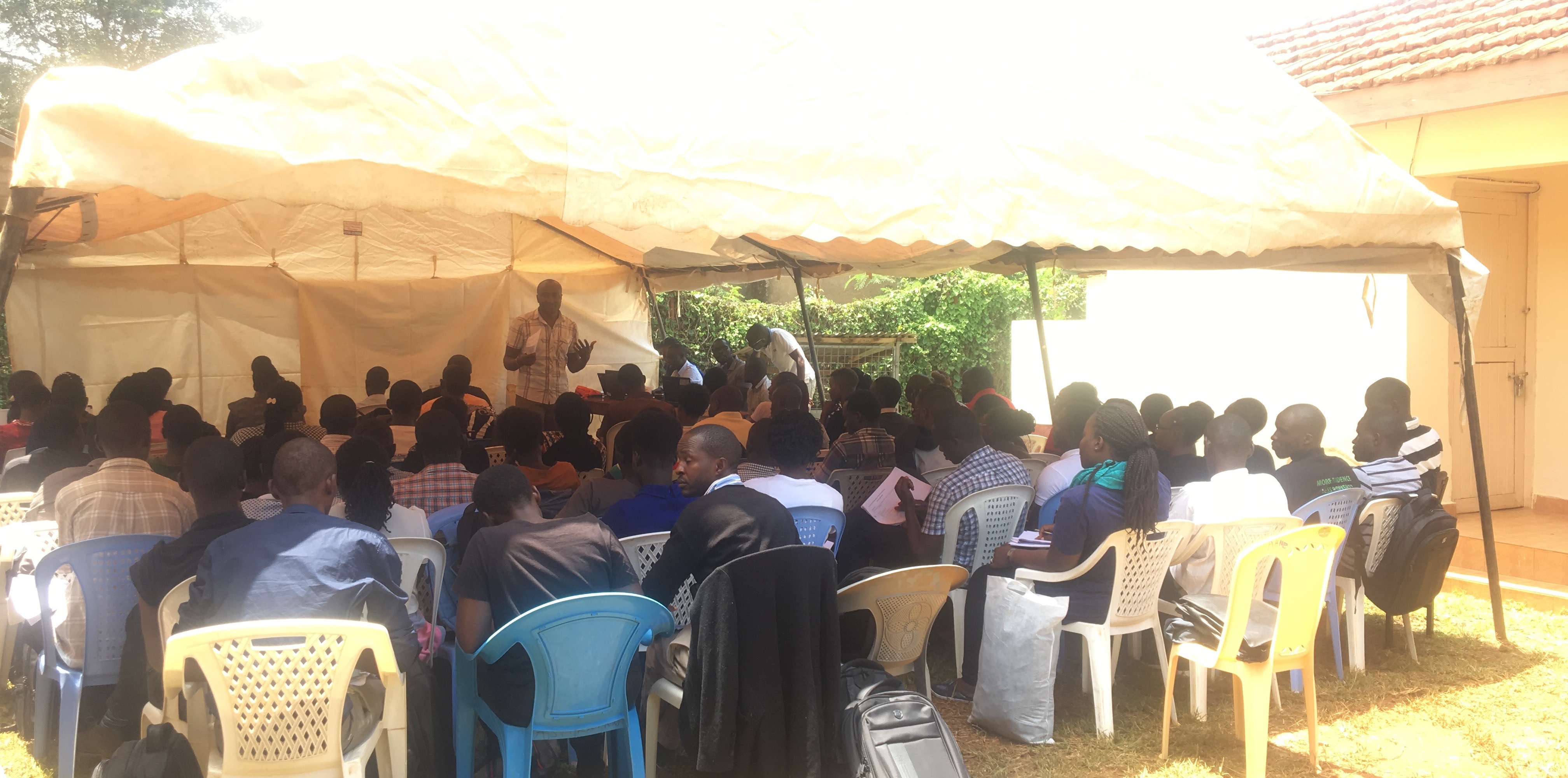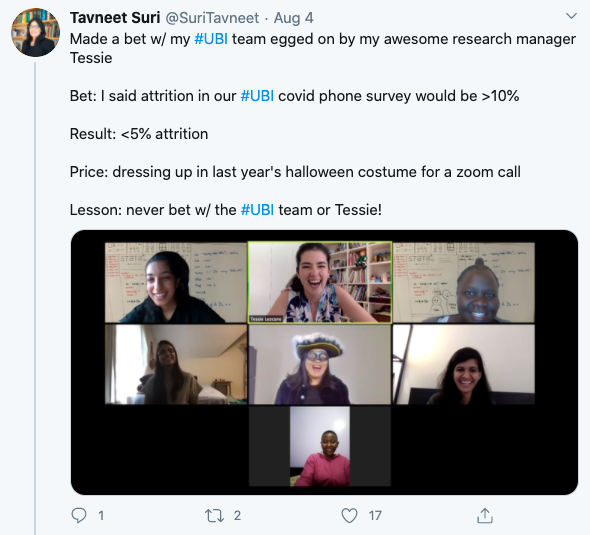Studying Universal Basic Income During COVID-19: A Behind-the-Scenes Look

Research Associate Bonnyface Mwangi conducts a training on the Household Survey for the original UBI endline in Siaya, Kenya (before the COVID-19 study).
Editor’s note: IPA was working on a randomized controlled trial of Universal Basic income with GiveDirectly and Professors Tavneet Suri, Paul Niehaus, Abhijit Banerjee, Michael Faye, and the late Alan Krueger, when the COVID-19 crisis hit. In nearly 195 villages in Western Kenya all adults over 18 years old had been receiving basic incomes—either in a lump sum, regular payments for two years, or regular payments for 12 years (enough to cover basic needs, the equivalent of about 75 cents/day). Data collection for the planned two-year follow-up had finished in December of 2019, and COVID-19 struck several months later. They knew it would be important evidence if they could study if and how much UBI helped people when a nationwide catastrophe hit, but at the time it was unclear if the same kind of research could be carried out under the lockdown conditions. Jeff Mosenkis from IPA's Communications and Policy team spoke with several members of the research team to ask what happened next.
Debborah Muthoki Wambua and Eunice Kioko are Research Associates, and Teresa Lezcano is a Research Manager, all with IPA Kenya, based in Nairobi. Tavneet Suri is Associate Professor of Applied Economics at the MIT Sloan School of Management.
Q: Can you describe what the first days of COVID were like in Kenya?
Debborah: It didn’t feel “real” in Kenya until February—it seemed like something far away, then we started seeing high numbers of cases in Spain and Italy. Our first case in Kenya hit around March 13 followed by two more cases on the 15th. Almost immediately the president announced the closure of schools. There was a lot of tension when we came into the office on Monday, wondering if we’d be working in the office, and the senior management decided to close the office and have everybody work from home. At the time, we still had field research teams following up with one of the arms of the study tracking people who had migrated. They were very far away from Nairobi where the COVID case was, so they weren’t in danger, but we soon told them to stop field activities as well.
We actually also had a phone survey component also at the time from our Nairobi office calling migrants who were too far to find in person but knew if we were going to do additional data collection we were going to have to switch everybody to phone, and most of our enumerators hadn’t been trained yet on how to do that.
Eunice: Doing phone surveys is very different from in-person interviews, and the field teams in the Bomet and Siaya counties hundreds of kilometers away had never done phone surveys. Those teams quickly got hand sanitizer and other protective equipment as they wrapped up the in-person work, and one of the Field Managers and I drove out there to make sure they were set up with everything they needed—phones, power backups for power outages (we were very concerned about that) and the like.
Q: Getting a new wave of data collection off the ground, creating with new surveys to measure health and economic impacts of COVID, and doing it in shorter phone sessions would be difficult in the best of times, but I can’t imagine what it must have been like as the country was going into lockdown?
Teresa: We were really lucky, the staff on this study are phenomenal, and we had support from U.S.-based RAs all of whom knew the instruments really well, and the PIs (economists running the study) were really responsive. The real challenge was managing staff who were all at home, normally even when we do phone surveys all the staff is together in one place, so having 55 staff all in different places made it tricky. We developed good protocols to track field officers’ productivity from home which helped immensely. We ended up speaking to the team as often as if we were all in the same room—through daily Zoom chats, WhatsApp messages, and phone calls. All this meant we were able to keep the attrition (non-response) rate very low.
Q: The paper said you had a 98 percent response rate, which is astounding! How did you manage that?
Eunice: I think that’s actually our highest completion rate, I think last year’s original endline (in person) was 97%. I want to say we didn’t expect it… We’d created a good rapport with respondents from visiting them in person.
Debborah: We had an elaborate protocol of how to arrange the calls. If people didn’t answer, we had a standard text message we sent explaining who we were and why we were calling. That helped a lot. And we had more senior managers ready to explain and offer more detail to people who were hesitant or suspicious. We also did about four days of Zoom training to try to ensure uniform procedures. That was a bit challenging but we figured it out.
Eunice: Because we’d been around the villages, we had good connections, and if someone’s phone had been off or not answering, we’d often ask the village elders to help us get in touch with them.
Q: Getting into findings, can you tell me about their economic situation and how it changed when COVID hit?
Tavneet: We’d seen an increase in people owning their own enterprises in the main endline survey, enterprises that survived through the COVID restrictions, and the hungry season (which came at the same time). However, we did see profits from these enterprises which were higher at endline, fell during the phone surveys conducted in May/June.
Eunice: On the new businesses, for example, people who’d been farmers had begun buying and selling things like groceries, secondhand clothes, and things like maize or beans and trading livestock.
Tavneet: It’s important to remember though that in lots of farming areas, income is always seasonal. As it happens, the COVID restrictions hit during the lean season, and we saw hunger went up in the control group a lot, but people who’d gotten UBI weren’t hit as badly. They’d started these businesses, taking risks, and when these hard times hit even when their income took a hit, they seemed better buffered from hunger.
Q: What are the lessons for effectiveness in general, and when there’s a sudden catastrophe?
Tavneet: We’ll have a whole bunch of other outcomes from the main endline when that paper comes out. We see from this survey in an area where there weren’t a lot of COVID cases, but there was a lot of suffering from the economics of the response, it’s possible that the UBI meant to encourage business creation isn’t the best solution. In the U.S. you have a pretty good idea of what businesses have been hit hard and we have programs to help them, but in many other countries, lots of small businesses aren’t registered, so you have no way of knowing who’s lost their income. It’s also not clear that a small stream of income is the way to help people who are taking big hits.
The other thing is we do see some positive health impacts—there were very few COVID cases there so it wasn’t about combating the disease specifically, but the people who’d gotten UBI were less likely to go to the hospital for other reasons so it might help the health system, in general, to have fewer sick people in the hospitals if those spaces are needed.
Q: What other lessons do you take away from this?
Tavneet: Well, to be honest, I had made a bet with the team about attrition, I had bet it would be at least 15% because most phone surveys have at least 20-25% attrition. I lost that bet terribly and ended up having to dress up for our next Zoom call in my Halloween costume. So I definitely learned to never bet against this team!












